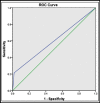qSOFA score for prediction of sepsis outcome in emergency department
- PMID: 32494253
- PMCID: PMC7260919
- DOI: 10.12669/pjms.36.4.2031
qSOFA score for prediction of sepsis outcome in emergency department
Abstract
Objective: The third international consensus definition for sepsis and septic shock (sepsis 3) task force recently introduced qSOFA (quick sequential organ failure assessment) as a score for detection of patients at risk of sepsis outside of intensive care units. We performed this study to evaluate the validity of qSOFA for early detection and risk stratification of septic patients in emergency department.
Methods: We conducted this study in an emergency department of the largest university affiliated hospital in northwest of Iran from Sept 2015 to Sept 2016. One hundred and forty patients who were SIRS positive with a suspected infection without alternative diagnosis and a microbiological proven infection were enrolled in this study. qSOFA was calculated for each patient and correlated with sepsis grades and mortality.
Results: From 140 patients 84 (60%) had positive qSOFA score and 56 (40%) patients had negative qSOFA score. Our results showed that near half of patients with positive qSOFA expired during their stay in hospital while this was about 5% for patients with negative qSOFA. ROC curve of study regarding prediction of outcome with qSOFA showed an area under curve of 0.59. (P value: 0.04). Time spent to sepsis detection was 16 minutes shorter with qSOFA score compared to SIRS criteria in this study.
Conclusion: In patients with suspected sepsis, qSOFA has acceptable value for risk stratification of severity, multi organ failure and mortality. It seems that education of medical staff and frequent screening of patients for warning signs can help to increase the value of qSOFA in prediction of mortality in critically ill septic patients.
Keywords: Emergency department; Sepsis; qSOFA ((quick sequential organ failure assessment).
Copyright: © Pakistan Journal of Medical Sciences.
References
-
- Cabrita JA, Pinheiro I, Menezes Falcao L. Rethinking the concept of sepsis and septic shock. Eur J Intern Med. 2018;54:1–5. doi:10.1016/j.ejim.2018.06.002. - PubMed
-
- Freund Y, Lemachatti N, Krastinova E, Van Laer M, Claessens YE, Avondo A, et al. Prognostic Accuracy of sepsis-3 Criteria for In-Hospital Mortality among patients with suspected infection presenting to the emergency department. JAMA. 2017;317:301–308. doi:10.1001/jama.2016.20329. - PubMed
-
- Raith EP, Udy AA, Bailey M, McGloughlin S, MacIsaac C, Bellomo R, et al. Prognostic Accuracy of the SOFA Score, SIRS Criteria, and qSOFA score for In-hospital mortality among adults with suspected infection admitted to the Intensive Care Unit. JAMA. 2017;317:290–300. doi:10.1001/jama.2016.20328. - PubMed
LinkOut - more resources
Full Text Sources

